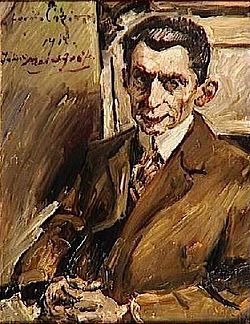
Julius Meier-Graefe
Encyclopedia

Germans
The Germans are a Germanic ethnic group native to Central Europe. The English term Germans has referred to the German-speaking population of the Holy Roman Empire since the Late Middle Ages....
art critic
Art critic
An art critic is a person who specializes in evaluating art. Their written critiques, or reviews, are published in newspapers, magazines, books and on web sites...
and novelist. His writings on Impressionism
Impressionism
Impressionism was a 19th-century art movement that originated with a group of Paris-based artists whose independent exhibitions brought them to prominence during the 1870s and 1880s...
, Post-Impressionism
Post-Impressionism
Post-Impressionism is the term coined by the British artist and art critic Roger Fry in 1910 to describe the development of French art since Manet. Fry used the term when he organized the 1910 exhibition Manet and Post-Impressionism...
as well as on art of earlier and more recent generations, with his most important contributions translated into French, Russian and English, are considered to have been instrumental for the understanding and the lasting success of these artistic movements.
Biography
In 1895 Meier-Graefe was involved in the setting up of the arts and literary periodical PanPan (magazine)
Pan was an arts and literary magazine, published from 1895 to 1900 in Berlin by Julius Otto Bierbaum and Julius Meier-Graefe. The magazine was revived by Paul Cassirer in 1910, published by his Pan-Presse....
and founded the Art Nouveau
Art Nouveau
Art Nouveau is an international philosophy and style of art, architecture and applied art—especially the decorative arts—that were most popular during 1890–1910. The name "Art Nouveau" is French for "new art"...
magazine Dekorative Kunst
Dekorative Kunst
Dekorative Kunst was a German avant-garde art magazine published from 1897 to 1929. The magazine promoted the Jugendstil or Art Nouveau style and was founded by Julius Meier-Graefe....
in 1897.
Writings
Der Fall Böcklin und die Lehre von den EinheitenEntwicklungsgeschichte der modernen Kunst, Vergleichende Betrachtung der bildenden Künste, als Beitrag zu einer neuen Aesthetik. 3 vols. Verlag Julius Hofmann, Stuttgart 1904
- 2nd revised and enlarged edition, R. Piper & Co. Verlag, München 1914 - 1922
Impressionisten: Guys - Manet - Van Gogh - Pissarro - Cézanne. Mit einer Einleitung über den Wert der französischen Kunst und sechzig Abbildungen. R. Piper & Co. Verlag, Munich & Leipzig ¹1907 & ²1907
-
- Three of these chapters have been reprinted separately, revised and enlarged:
- Edouard Manet
- Vincent van Gogh, R. Piper & Co., Munich (Cover design after a drawing by Vincent van GoghVincent van GoghVincent Willem van Gogh , and used Brabant dialect in his writing; it is therefore likely that he himself pronounced his name with a Brabant accent: , with a voiced V and palatalized G and gh. In France, where much of his work was produced, it is...
)- 4. - 6. Td.; 50 ill. and facsimile of a letter. R. Piper & Co., Munich 1912 (published in two printings with deferring illustrations!)
- 4th, improved edition; 50 ill. (not 40 ill., as stated on the title page!) and facsimile of a letter. R. Piper & Co., Munich 1918
- 5th, improved edition; 50 ill. and facsimile of a letter. R. Piper & Co., Munich 1922
- 6th, improved edition, 14. - 16. Td.; 54 ill. and facsimile of a letter. R. Piper & Co., Munich 1929
- Paul Cézanne, R. Piper & Co., Munich (Cover designed by Franz MarcFranz MarcFranz Marc was a German painter and printmaker, one of the key figures of the German Expressionist movement...
, after a painting by Paul CézannePaul CézannePaul Cézanne was a French artist and Post-Impressionist painter whose work laid the foundations of the transition from the 19th century conception of artistic endeavour to a new and radically different world of art in the 20th century. Cézanne can be said to form the bridge between late 19th...
)- 5th, totally revised edition, 7. - 10. Td.; 38 ill. R. Piper & Co., Munich 1923
Auguste Renoir, R. Piper & Co., Munich
-
- 5th edition, "to be published 1924"
Courbet
- Re-edited 1924
Vincent, 2 vols. 103 plates. R. Piper & Co., Munich ²1922
- Pre-release serialised in Der Neue Merkur 3 (1919/1920)& 4 (1920/1921):
- Vincent und Theo, Der Neue Merkur 3 (1919/1920), special issue: "Werden", pp. 37-78
- Van Gogh in Paris, Der Neue Merkur 4 (1920/1921), pp. 143-169
- Van Gogh in Arles, Der Neue Merkur 4 (1920/1921), pp. 445-460
- Das Gelbe Haus, Der Neue Merkur 4 (1920/1921), pp. 523-532
- Van Gogh und Gauguin, Der Neue Merkur 4 (1920/1921), pp. 622-643
- Fou-Roux (Der rote Narr), Der Neue Merkur 4( 1920/1921), pp. 685-696
- Van Gogh in St. Remy, Der Neue Merkur 4 (1920/1921), pp. 769-786
- Das Ende Van Goghs, Der Neue Merkur 4 (1920/1921), pp. 822-841
Vincent van Gogh, der Zeichner. 52 plates. Otto Wacker-Verlag, Berlin 1928
-
- printed in December 1927, see colophon
Renoir, Klinkhardt & Biermann Verlag, Leipzig 1929, with 407 illustrations and 10 plates
- Gestandnisse meines vetters - novellen , 1923 , Ernst Rowohlt verlag in Berlin

